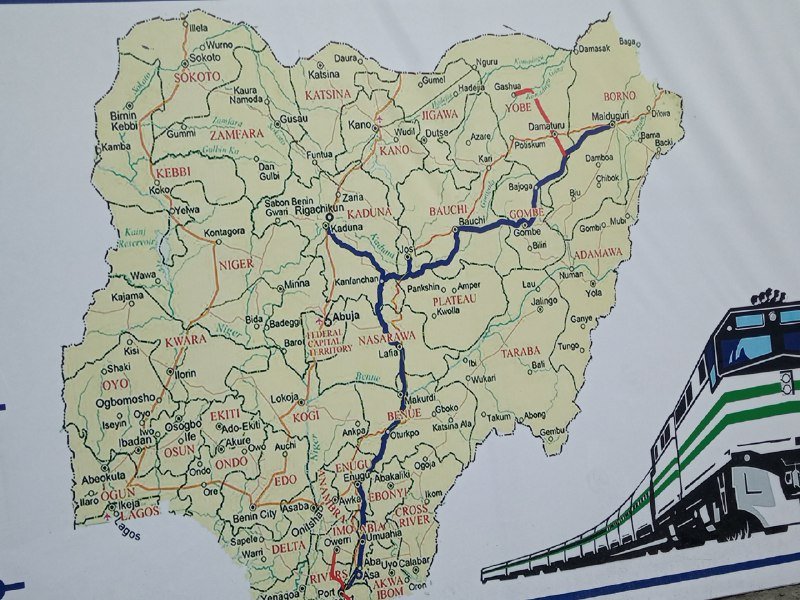The Minister of Transportation Rotimi Amaechi, on Wednesday brought the dividends of democracy closer home, as he, on behalf of his principal, President Muhammadu Buhari, performs the ground breaking of the Port Harcourt-Maiduguri railway project.
The Eastern Narrow Gauge Railway project with a construction time of 36 months estimated at about 1,000 kilometres, is expected to cost $3billion, with the Federal Government obligated to pay only 15 percent counterpart funding.
Instructively, the project is coming with two new elements – the link to the Bonny Deep seaport and the Railway Industrial Park – to be located in Port Harcourt.
FG Reveals When Lagos-Ibadan railway Will Commence Operations
The project, which would be executed by the China Civil Engineering Construction Corporation, (CCECC), had been approved since September, to link Port Harcourt on the Atlantic Coast, southsouth, to Maiduguri, on the border with chad, on northeast Nigeria.
Amaechi, who broke the news to reporters during his routine inspection of the Lagos-Ibadan standard gauge rail project, expressed happiness that at last his people would be happy that the railway is, at least, coming closer home.
The minister added that two new spurs (branch lines) may be added to the project to link Abakaliki, Ebonyi State capital and Awka, the Anambra State capital, thereby achieving the dream of linking the Southeast capitals by rail system.
He clarified that the ground breaking entailed only the take-off of front end engineering procedures including engineering designs and planning, after which the actual construction is expected to begin.
What Presidency Said About Nigeria Building Rail Line Into Niger Republic
On the viability of the corridor, Amaechi said though the Lagos-Kano rail could move 30 million tons of cargo; when completed, the Port Harcourt-Maiduguri line would move 11 million tons of cargo.
He said: “When we complete the railways, there are certain cargoes that will no longer be allowed on the roads.
“This is to encourage the movement of cargo on the rail lines and to ensure that our roads are preserved.
“Moving cargo across the country through rail would be cheaper and faster than the roads.”
The Global Construction Review, a website of the Chartered Institute of Building, quoted the minister as saying last year, that the Federal Executive Council has approved the award of contracts for the rehabilitation and reconstruction of the Port Harcourt to Maiduguri narrow-gauge railway, with new branch lines and transshipment infrastructure. These are the construction of a deep-sea port in Bonny and a railway industrial park in Port Harcourt.
See How Much Nigerians Will Pay For 1st Class Seat On New Lagos-Ibadan Rail
According to the website, the minister said the reconstruction of the railways would cost around $3billion. The industrial park is expected to cost $240million and the port $480million.
These last two projects would be developed as public–private partnerships “at no cost to the federal government”.
The port at Bonny will have a rail connection to the Port Harcourt line. Others will be built to Owerri, the Imo State capital, and Kafanchan in Kaduna State.
The Eastern rail line project was started by the British colonialists from Port Harcourt to Enugu, 243 km between 1914 and 1916, from Enugu it extended to Makurdi 223km from 1916–1924, and from Kaduna to Kafranchan 179 km 1924-1927, and Kafranchan to Jos, 101 km from 1924 -1927.
For about 31 years, 1927 -1957 there was a lull in railway development until 1958, when the rail line was extended from Kafanchan to Bauchi in 1961, 238 kms and, ultimately, to Maiduguri 302 kms from 1963 to 1964.
Demolition Of Facilities In Enugu Can Frustrate Railway Extension To South East-NRC
This development, in addition to the western narrow gauge rail line, brought the nation’s total narrow gauge assets to 2,505 and track kilometres to 4,332 managed by the Nigerian Railway Corporation.
From its peak of glory, regarded as the golden age of the early ‘60s, the railway fell into stormy waters, because there were no comprehensive maintenance provision for the narrow gauge, and the corporation went into bankruptcy.
The corporation existed in fits and starts until 2002, when the government birthed the 25-year strategic vision for the railway, which favoured the modernisation of the rail system with the construction of the standard gauge.
The vision has three phases: Phase One; system transition from 2002 to 2007, entails the transition of the narrow gauge rehabilitation which narrow gauge functions effectively and become attractive to concessionaires. Phase two includes system modernisation from 2007 to 2015, and both phases are being implemented concurrently and because of some delays in budgetary allocation and implementation, which involves the construction of new standard gauge infrastructure and the attraction of private investment and modernisation of operations and increasing local technological capacity.
Amaechi Threatens: I Will Shut Down Train Service If….
Phase Three system stabilisation 2015 to 2027. This will consolidate on the advancements of the two previous phases with the extension of new routes to reach all the state capitals and commercial centres and effective commercialisation of rail operations and development of high speed lines with optimal efficiency.
The Port Harcourt narrow gauge rail line would have been in total comatose but for skeletal services being provided by the NRC between Port Harcourt and Calabar, which has been suspended due to COVID-19 and loss of tracks.
In May 2010, former President Goodluck Jonathan launched an ambitious rail rehabilitation project meant to see the rail network rehabilitated. One of the lines identified for immediate rehabilitation was the Port Harcourt-Maiduguri corridor, which was partitioned into three contracts, the 463 km Port Harcourt- Makurdi, which collapsed and was abandoned, in need of reconstruction and rehabilitation.
Logistics stakeholders said the rehabilitation of the rail corridor would unleash huge economic potential of the areas and support economic diversification and job creation.
Post Disclaimer
The opinions, beliefs and viewpoints expressed by the author and forum participants on this website do not necessarily reflect the opinions, beliefs and viewpoints of Anaedo Online or official policies of the Anaedo Online.

